|
Spitfire Mk.IXc Late Version

Eduard ProfiPACK, 1/48 scale
S
u m m a r y |
| Catalogue Number: |
Eduard Kit No. 8281 - Spitfire Mk.IXc Late Version ProfiPACK |
| Scale: |
1/48 |
| Contents and Media: |
192 parts in grey coloured plastic; 14 parts in clear; colour photo-etched fret; self-adhesive die-cut masking sheet; markings for five aircraft |
| Price: |
USD$42.46 plus shipping,
available online from Eduard |
| Review Type: |
FirstLook |
| Advantages: |
Accurate fuselage and wing dimensions; very high level of detail; outstanding surface
features including crisply recessed panels and subtle rivet lines where
appropriate; includes colour photo-etched parts; separate parts for closed and open canopy; many options including kinked/straight elevators, two styles of gear doors, two different upper engine cowlings, clipped or full-length wing tips, three types of wheel hubs (four spoke, five spoke and covered), bombs and pointed/rounded rudder. |
| Disadvantages: |
Incorrect proportions for wing B type roundels; flare rack on seat should be omitted. |
| Conclusion: |
At last, the 1/48 scale Spitfire that this legendary marque deserves. After false starts from many model companies, Eduard has delivered the definitive 1/48 scale Spitfire Mk.IX - accurate dimension, impressive detail, many options and the suggestion of a growing family of variants. Highly Recommended. |
Reviewed by Brett Green

Eduard's 1/48 scale Spitfire Mk.IXc Late Version will be available online from Squadron.com
The Focke-Wulf Fw 190 asserted its authority as soon as it appeared over the Channel Front in September 1941. It was so clearly superior to the Spitfire Mk.V that RAF Fighter Command curtailed operations twice - from November 1941 to March 1942, and again from 13 June 1942 - due to unacceptably high losses against the Luftwaffe's "Butcher Bird".
The Rolls-Royce Merlin 60 series engines would offer the Spitfire the essential edge it needed to balance the scales against this new foe, but the high altitude Spitfire Mk.VII and the unpressurised Mk.VIII were still many months away from production.
An interim proposal was therefore made to provide a suitable solution in a more timely fashion. The Merlin 61 engine would be fitted to the existing Spitfire Mk.V airframe, matching the Fw 190s performance at medium and high altitudes. This aircraft was known as the Spitfire F.Mk.IX, Type No.361.
The resulting Spitfire retained the clean lines of the earlier Mks. I, II and V, but featured a longer and modified fuselage to accommodate the bigger engine, revised intakes, radiators and oil coolers, and a four-bladed propeller to absorb the greater power.
Although initially conceived as a stop-gap measure, the Spitfire Mk.IX and the essentially similar Mk.XVI (powered by a Packard Merlin engine) eventually became the most numerous of all Spitfire variants with more than 7,000 delivered to the RAF, the VVS and other Allied air forces.
The initial production version of the Spitfire Mk.IXc could be distinguished by a small carburettor intake below and behind the nose, elevators with diagonal mass balances and wide blisters on top of the wings covering both cannon bays.
Typical external characteristics of the later Spitfire Mk.IXc included narrow wing blisters over the inboard cannon bay only, new kinked mass balances on the elevators and a wider, longer carburettor intake. Some Mk.IXcs were also fitted with the tall pointed rudder from the Mks.VII and VIII.
The Spitfire Mk.IX continued in front line service until the end of the Second World War and beyond.
The Spitfire Mk.IX in 1/48 scale
The search for the ideal 1/48 scale Spitfire Mk.VIII / IX / XVI has been something akin to the quest for the Holy Grail. Every time modellers get a whiff, that potentially perfect Spitfire rapidly recedes into the mist.
Back in the 1990s, hopes were high for the Ocidental offering, but that kit had some serious dimensional and cross-section problems. The ICM 1/48 scale Spitfire IX was more accurate, but early pressings were plagued with moulding flaws and the fuselage was skinny. Over-engineering also made this kit a challenge to build.
Released in 2001, Hasegawa's 1/48 scale Spitfires were well detailed, but the whole family was blighted with a noticeably short fuselage and related detail issues.
It was Airfix's turn in 2007, but their Mk.IXc suffered from a long list of shortcomings. The wing, rudder and horizontal tailplanes were very thick, and the dropped flaps were an unnecessary gimmick. The shape of the propeller blades was poor, as were the blobby exhausts and the slab-like cannon bulges on top of the wings. Canopy parts were far too thick for this day and age as well.
It seemed that this great aviation icon was cursed.
Eduard's announcement of a forthcoming 1/48 scale Spitfire Mk.IXc generated great anticipation, especially considering the level of detail and finesse of their latest releases. Would the 1/48 scale Spitfire IX curse be lifted at last?
Eduard's 1/48 scale Spitfire Mk.IXc Late Version comprises 192 parts in grey plastic, 14 parts in clear, a colour photo-etched fret, self-adhesive masks for the canopy and markings for five options.
Of these parts, 36 are marked not for use and quite a few more are optional.
Outline Accuracy
I was particularly interested to see if the fuselage was the correct length, as this is the criticism most often levelled against the Hasegawa kit. Considering the controversy about which drawings are reliable and which are not, I decided instead to measure the Eduard fuselage against the very well-regarded Aeroclub 1/48 scale Spitfire Mk.IX corrected fuselage.
The length of the Eduard kit matched the length of the Aeroclub fuselage almost exactly from the rudder hinge line to the front of the nose (the Aeroclub fuselage half is closest to the camera in the image below). The profiles of the fuselages also matched closely, with the Eduard kit being perhaps a millimetre deeper at the back of the wing root. Other critical elements such as the location of the wing and the horizontal tailplanes were also very close.
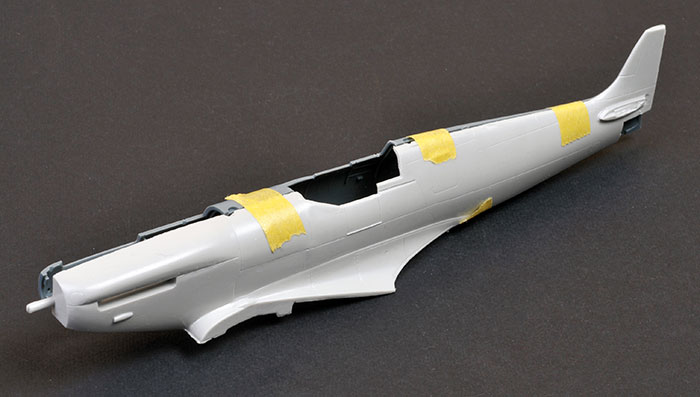
The Eduard lower wing was then offered up to its Hasegawa counterpart. The span without the wing tips is close enough to be considered identical.
As far as I was concerned, the model had passed its first and possibly most important test - general dimensional accuracy looks very good.
Surface Detail
If you have have admired the surface detail on any of Eduard's recent releases, you won't be disappointed with this one.
Panel lines are very crisp, fine and even. Lines of rivets are present, but they are incredibly subtle - at least the equal of those found on Eduard's exquisite 1/72 scale Bf 110s.
The rivet lines seem to accurately follow the pattern applied to the full-sized aircraft too.
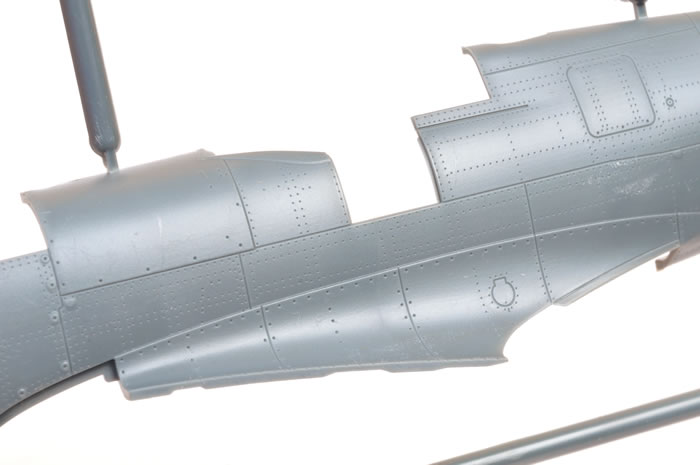
It is difficult to accurately portray the rivets in photographs, as studio lights tend to overemphasise them, especially on the bare plastic.
The rivets are visible on the real aircraft too, but the degree of prominence will depend on a number of factors - the gloss level of the paint, lighting, weathering, the angle and distance of the observer and more.

These photos show the airworthy Spitfire Mk.VIII at the Temora Aviation Museum taken during a visit in 2009. Granted, this example is glossy and restored but the rivet patterns are very obvious when viewed close-up.

Just like on the real aircraft, after a coat of matt paint and putting a little distance between the observer and the model, the rivet detail will be almost invisible (unless you decide to emphasise it with washes and other weathering techniques, but that is entirely your prerogative!)
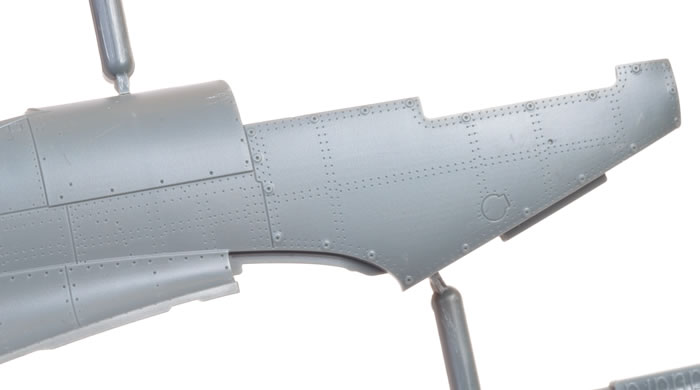
There are some raised details too, including the cowl fasteners and patches over the wing machine gun ports. In my opinion, these are reasonably restrained (once again, looking exaggerated in this photo under the studio lights) and I will probably leave them all in place.

The fasteners are visible on the real aircraft (this time Temora's Mk.XVI, which features flatter paintwork) but if the raised version on the kit are not to your taste it will be a simple matter to sand them down.
Fabric detail is equally impressive, with strip and stitching texture beautifully presented on the control surfaces.
Detail
Eduard combines plastic and colour photo-etched parts in their ProfiPACK, delivering a very high level of detail straight from the box. The cockpit benefits most from the photo-etch with a nice multi-layered instrument panel, coloured harness straps and scale-thickness pilot's armour.

Eduard has not attempted to colour the armour plate, which I think is a good call considering the amount of interpretation that might be applicable to British Interior Grey Green!
Eduard's instructions indicate that the flare rack (Part F47) should be glued to the front of the pilot's seat, but this was not fitted to the Mk.IX. Just leave it off.
The wheel wells and undercarriage parts are really well detailed.
The wheel well openings are slightly oval in shape. This seems to correspond with the shape shown in the plans in Robert Bracken's book, "Spitfire - The Canadians" (Volume One).

The exhausts are the fishtail type. They are supplied in one piece for each side and the stacks are hollowed out at the end. Nice!

Engineering and Options
The kit is broken down conventionally. The fuselage is full-length with the only insert being the forward wing root (one part with a blister fairing and one without). The top engine cowling is split lengthwise into two pieces and two versions are offered. The instructions advise which version applies to what marking option.
The lower cowl is separate too. The late and early versions are included, but the early version cannot be used yet as the back half of the big late-version carburettor intake is moulded in place on the lower mid wing.
The wings are also moulded without inserts. The narrow C wing bulges are moulded in place over the inboard cannon bay.

Ailerons, elevators and the rudder are all separate, while the flaps are moulded closed. This is another sensible decision, as the flaps were rarely seen dropped at any time other than on final approach to landing.
The early elevators with the straight diagonal mass balance are provided as well as the late kinked version. The elevators are moulded as matched pairs, joined in the middle with a plastic connector. This will ensure that the droop (or otherwise) is consistent when the elevators are glued in place.
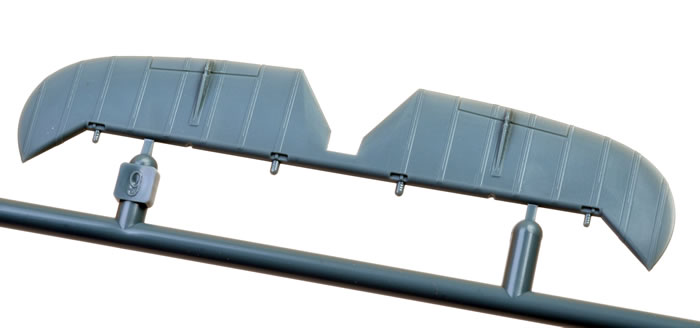
The early rounded and later tall pointed rudder are also included.

Other options include a choice of wheel hubs (four spoke, five spoke and covered, with photo-etched covers supplementing the plastic parts); two styles of gear doors, two 250 lb British bombs and racks; and standard or clipped wing tips.
In fact, the modeller is offered two options for the clipped wing tips - one set is clear and the other moulded in grey plastic.
The canopy side door is a separate part too, with the option of posing the door open or closed.
The clear parts are free from distortion and quite thin.
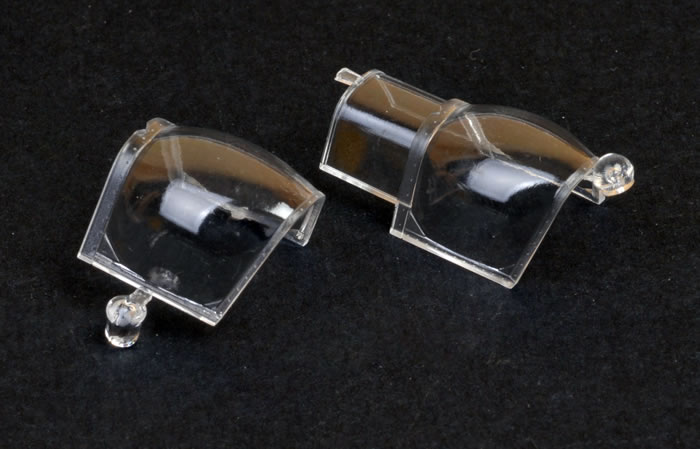
The closed canopy option comprises a combined sliding section and rear section, while the open canopy supplies a separate sliding section to sit over the rear clear part.
Markings
Markings are supplied for five aircraft, including one with alternate markings:
-
Spitfire LFMk.IXc, MH712, flown by W/O Henryk Dygala, No. 302 Squadron, Summer / Autumn, 1944
-
Spitfire HFMk.IXc, MJ296, flown by F/Lt Otto Smik, No. 312 Squadron, North Weald AB, Late August, 1944
-
Spitfire LFMk.IXc, MJ586, flown by Pierre Clostermann, No. 602 Squadron, Longues sur Mer airfield, July 7, 1944
-
Spitfire LFMk.IXc, MJ250, No. 601 Squadron, Italy, Summer, 1944
-
Spitfire LFMk.IXc, ML135, flown by Jerry Billing, No. 401 Squadron, Tangmere AB, June 7, 1944
-
Spitfire LFMk.IXc, ML135, flown by Jerry Billing, No. 401 Squadron, France, July 1, 1944
Everything is in register on my sample but the red of the upper wing Type B roundels is too large.

The colours look very bright in my photo but they are not as lurid under normal lighting, although the blue may be a little bit too light.
The curse has been lifted. This is the 1/48 scale Spitfire Mk.IX that many of us have been hoping for.
In my opinion, Eduard has delivered easily the best late mark Merlin Spitfire available in 1/48 scale.
The kit is fundamentally accurate, well detailed, with state-of-the-art surface textures and lots of useful options.
I was pleased to see that this model did not go down the route of engine detail and poseable flaps. In fact, parts breakdown is quite conventional and construction should be straightforward, so Eduard's Spitfire will be suitable even for relatively inexperienced modellers.
Although detail really is very good straight from the box, superdetailers have been catered for with a suite of BRASSIN and photo-etched upgrades including a multimedia cockpit, exterior details, enhanced cockpit photo-etch and even the notorious dropped flaps if you really must! All of these are available right now, and we will be examining them next week on HyperScale.
The sprues also offer some tantalising hints of things to come. Certainly, many of the parts needed for the Mk.IXc early version are already in the box, and a Mk.IXe would only require a new wing, but it would not be a stretch to imagine an Eduard Spitfire Mk.VIII in the near future too (the separately available block-tread BRASSIN tyres are a clue, as these seemed to have been almost exclusively used on RAAF Mks. Vc and VIII).
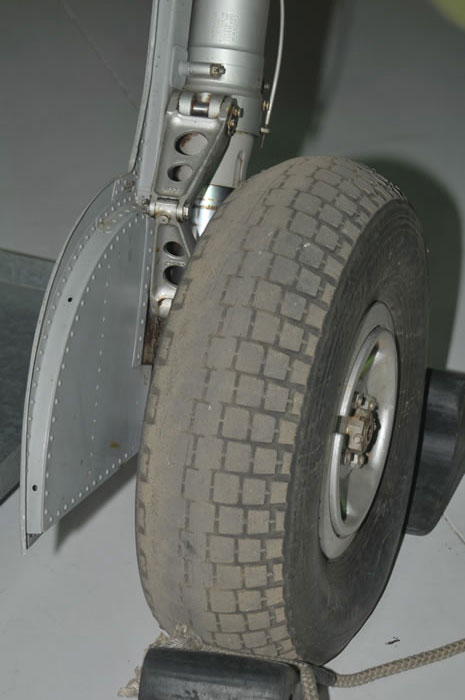
Eduard has made a fantastic start to their Spitfire family with this kit. I can't wait to build mine.
Highly Recommended.
Thanks to Eduard for the sample
Review Text Copyright © 2013 by
Brett Green
Page Created 5 April, 2013
Last updated
9 April, 2013
Back to HyperScale Main Page
Back to Reviews Page |
